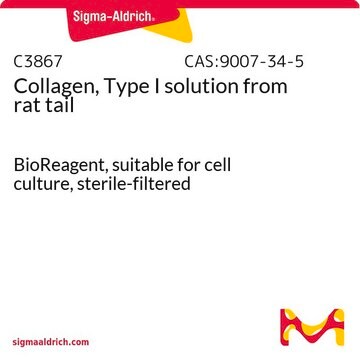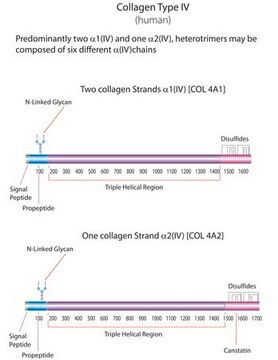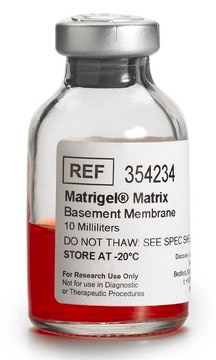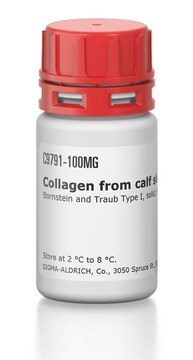C0543
Rat Collagen Type IV
from Engelbreth-Holm-Swarm murine sarcoma basement membrane, lyophilized powder, suitable for cell culture, used for 3D hydrogel formation
Sinônimo(s):
Type IV collagen, EHS-collagen
About This Item
Produtos recomendados
Nome do produto
Collagen from Engelbreth-Holm-Swarm murine sarcoma basement membrane, Type IV (Miller), lyophilized powder, BioReagent, suitable for cell culture
fonte biológica
mouse (Engelbreth-Holm-Swarm murine sarcoma basement membrane)
Nível de qualidade
tipo
Type IV (Miller)
linha de produto
BioReagent
Formulário
lyophilized powder
embalagem
glass bottle of 1 vial
técnica(s)
cell culture | mammalian: suitable
cobertura de superfície
6‑10 μg/cm2
solubilidade
0.25% acetic acid: 0.5-2.0 mg/mL (Keep at 2-8 °C for several hours, occasionally swirling.)
Condições de expedição
dry ice
temperatura de armazenamento
−20°C
Informações sobre genes
mouse ... Col4a1(12826) , Col4a2(12827) , Col4a3(12828) , Col4a5(12830) , Col4a6(94216)
Descrição geral
Aplicação
- in adhesion assays.
- in hydrogel fabrication.
- to coat cell culture plates for cell differentiation.
- to treat round plastic coverslips for scanning electron microscopy (SEM) analysis in an interaction study between A. culbertsoni trophozoites and Schwann cells.
Ações bioquímicas/fisiológicas
Outras notas
Quantidade
Nota de preparo
Pepsin is not used in the preparation.
Código de classe de armazenamento
11 - Combustible Solids
Classe de risco de água (WGK)
WGK 1
Ponto de fulgor (°F)
Not applicable
Ponto de fulgor (°C)
Not applicable
Equipamento de proteção individual
Eyeshields, Gloves, type N95 (US)
Escolha uma das versões mais recentes:
Já possui este produto?
Encontre a documentação dos produtos que você adquiriu recentemente na biblioteca de documentos.
Os clientes também visualizaram
Artigos
3D cell culture overview. Learn about 2D vs 3D cell culture, advantages of 3D cell culture, and techniques available to develop 3D cell models
Cancer stem cell media, spheroid plates and cancer stem cell markers to culture and characterize CSC populations.
Extracellular matrix proteins such as laminin, collagen, and fibronectin can be used as cell attachment substrates in cell culture.
Nossa equipe de cientistas tem experiência em todas as áreas de pesquisa, incluindo Life Sciences, ciência de materiais, síntese química, cromatografia, química analítica e muitas outras.
Entre em contato com a assistência técnica










